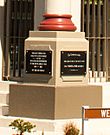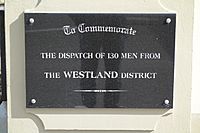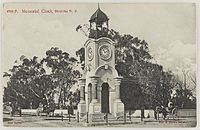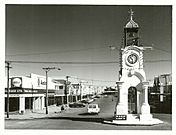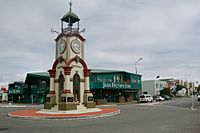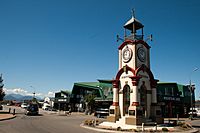Hokitika Clock Tower facts for kids
Quick facts for kids Hokitika Clock Tower |
|
|---|---|
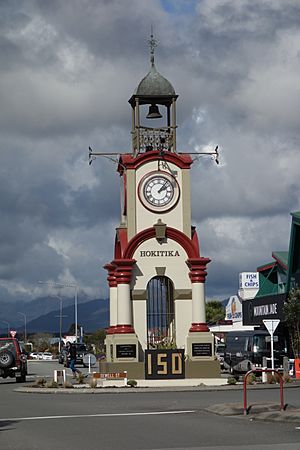
The Hokitika Clock Tower in 2015 with a "150" sign commemorating the sesquicentennial of Westland the previous year
|
|
| Location | Hokitika, New Zealand |
| Built | 1902–1903 |
| Built for | Queen Victoria's Diamond Jubilee |
| Architect | William Parkinson |
| Governing body | Westland District Council |
| Official name: Memorial Clock Tower | |
| Designated | 21 September 1989 |
| Reference no. | 5054 |
The Hokitika Clock Tower is a famous landmark in Hokitika, New Zealand. It was first called the Westland War Memorial. Later, it was also known as the Coronation and War Memorial.
This special tower was built to remember the people from the Westland region who fought in the Second Boer War. This war happened in South Africa. The tower honors not just the four local men who died, but all 130 who went to war. It also serves as Hokitika's town clock.
Henry Michel, who was the mayor of Hokitika at the time, was the main person who pushed for the tower to be built. People raised money for it. Then, it was decided the tower would also celebrate the upcoming coronation of King Edward VII.
Richard Seddon, a former Hokitika resident and then the country's leader (Premier), supported the project. He helped lay the first stone and gave a big speech when the tower was officially opened in June 1903. His wife also helped raise a lot of money for the tower in Wellington. Today, the tower is in the middle of a roundabout on the main road into Hokitika. It looks almost the same as when it was built. Since 1989, it has been listed as a national heritage site.
Contents
History of the Clock Tower
Hokitika is located on the West Coast of New Zealand's South Island. In September 1899, Richard Seddon, who was New Zealand's Premier and represented the local area, agreed to send soldiers to South Africa. This was to help Britain in a growing conflict. The Second Boer War started on October 11, 1899. The Westland region sent 130 men to fight, and four of them died.
Planning the Memorial
In June 1900, a group called the Peace Celebration Committee was formed in Hokitika. They decided to build a memorial. It would list the names of all the Westland men who went to war. It would also celebrate the peace that would eventually come. The mayor of Hokitika, Henry Michel, was very important in making this memorial happen.
In October 1901, they chose to put the memorial in the middle of the intersection of Sewell and Weld streets. This spot had been used before for a memorial to four early West Coast settlers who died in the 1860s. That old memorial had been moved to the Hokitika Cemetery. The town council approved the site in November 1901.
The committee then held a public competition for a motto for the monument. They received 40 ideas. The chosen motto was the Latin phrase Non sibi sed patriae. This means "Not for self, but for country". Miss Vida Perry submitted this motto and won a prize.
Building and Unveiling
On February 14, 1902, Premier Seddon laid the foundation stone for the memorial. This was a big event with many people attending, even though it was raining. Seddon's wife, Louisa Jane Seddon, had helped raise money for the project. She collected NZ£70 from people who used to live on the West Coast but now lived in Wellington.
It took more than a year to build the monument. During this time, Edward VII became king in August 1902. So, it was decided that the memorial would also honor his coronation. The Hokitika Clock Tower is one of a few memorials in New Zealand that remembers both the Boer War and King Edward VII's coronation.
The clock tower was officially opened on June 3, 1903. This was the birthday of the Prince of Wales, George Frederick Ernest Albert. The weather was perfect, and a huge crowd of 5,000 people came to see it. Over 3,000 of them arrived by train. Mayor Michel spoke first. Then, Seddon's wife unveiled the clock tower. Seddon himself gave a long speech. Other important people also gave short speeches.
On September 21, 1989, the Hokitika Clock Tower was officially recognized as a Category II heritage structure. This means it is an important historical building. It is a very well-known landmark in the town.
Construction and Changes
The company chosen to design and build the memorial was William Parkinson, a stonemason from Auckland. This company had built other important monuments before. Even though the foundation stone was laid in February 1902, the final design for the memorial wasn't agreed upon until July of that year. The memorial was built in Auckland. Then, its parts were shipped to Hokitika to be put together.
A clock with four faces was ordered from Gillett & Johnston in Croydon, England. It was installed by Alfred Bartlett from Auckland. It's quite unusual in New Zealand for a war memorial to also have a town clock. In Hokitika, there wasn't much discussion about this dual purpose. However, in another town, Invercargill, adding a clock to a war memorial caused a lot of debate.
Tower Design
The memorial has a square concrete base that is about 3.4 metres (11 ft) wide and 0.91 metres (3 ft) high. This base supports four smaller square bases at each corner. Each of these smaller bases has two memorial tablets on its outer faces. One of these tablets shows the chosen motto: "Not for self, but for country."
Above these square bases are round columns with decorative tops. Arches with a central stone connect the columns, creating a striking look. Above the arches, the square tower holds the clock. Each clock face is surrounded by a circular stone. The top part of the stone tower has molded arches.
On top of the masonry tower is a belfry. This part has iron columns, decorative ironwork, and four bells that chime. It is topped with a copper cupola and a decorative iron finial. Only a few other Boer War memorials in New Zealand have a cupola. The tower is made of Mount Somers / Te Kiekie stone, except for the columns, which are made of bluestone. The tower measures about 11.4 metres (37 ft 6 in) to the very top.
- Memorial tablets on northern square base
Changes Over Time
The belfry, which is the part holding the bells, started to rust. It was replaced in 1957. When the tower was first built, it had a square iron fence around its base. This iron fence was removed. The base was then made a bit larger, changing into an octagon shape. Later, a much larger circular concrete ring was added around the base. This ring helps the intersection work as a roundabout. This concrete ring was later decorated with plants and landscaping.
- Changes to the tower's base
See also
 In Spanish: Torre del Reloj de Hokitika para niños
In Spanish: Torre del Reloj de Hokitika para niños




